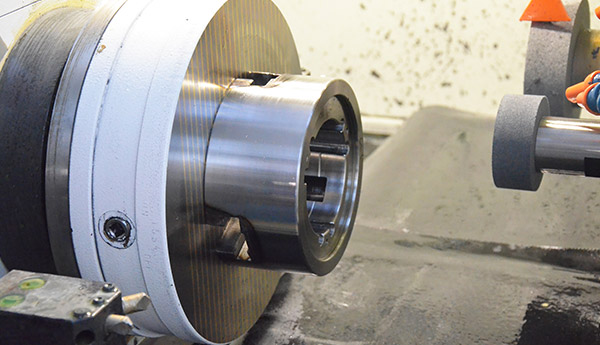11. 01, 2019
(1) Clamping and loosening of the hydraulic chuck. When the hydraulic chuck is clamped, the hydraulic oil enters from the B port, enters the hydraulic control check valve through the oil hole, and pushes the piston to the right to enter the hydraulic cylinder H cavity to realize the clamping of the hydraulic chuck. When the hydraulic chuck is relaxed, the hydraulic oil enters through the A port, and the hydraulic control check valve is opened through the oil hole, and the hydraulic oil enters the G chamber of the rotary hydraulic cylinder to push the piston to the left to realize the relaxation of the hydraulic chuck.
(2) The hydraulic chuck is top clamped and relaxed. When the top is in the tight state, the hydraulic oil enters from the D port, enters the K-cavity of the top hydraulic cylinder through the oil hole, and the ejector rod moves to the right to achieve the top tightening. When the top is tight, the hydraulic oil enters from the E port, enters the F chamber of the top hydraulic cylinder through the oil hole, and the ejector rod moves to the left to achieve the top tightening.
(3) The function of the hydraulic control single valve. There is a check valve on the hydraulic system, but considering that the hydraulic system is far away from the operating mechanism and there is a leakage problem, the hydraulic control check valve is installed on the flange of the hydraulic cylinder to avoid leakage. The pressure loss is also getting better and better to achieve the check and hold function of the load.
(4) Sealing ring. The movable sealing elements of the chuck rotary hydraulic cylinder and the movable top hydraulic cylinder adopt the grid ring and the seal assembly. The dynamic and static sealing effects are good; the performance is good when there is lubrication and no lubrication; it has the characteristics of low friction resistance, simple groove structure, no creep phenomenon and no stickiness.
(5) The hydraulic cylinder cylinder and the top hydraulic cylinder are equipped with hydraulic cylinder sleeves 9 and 14 in sequence, and the hydraulic cylinder sleeve material is GCr15. The material has relatively high internal wear and fatigue resistance, and the hardness is relatively high after quenching. Therefore, the service life of hydraulic cylinders is much higher than that of ordinary hydraulic cylinders, and It is convenient to replace the hydraulic cylinder after it is damaged.
(6) Testing agency. The clamping and relaxation of the hydraulic chuck and the top tightening and relaxation are detected through the positioning plate and the proximity switch, making the machine operation safer and more reliable.

Anterior: How to Choose The Right Chuck?
Próximo: Ninguno